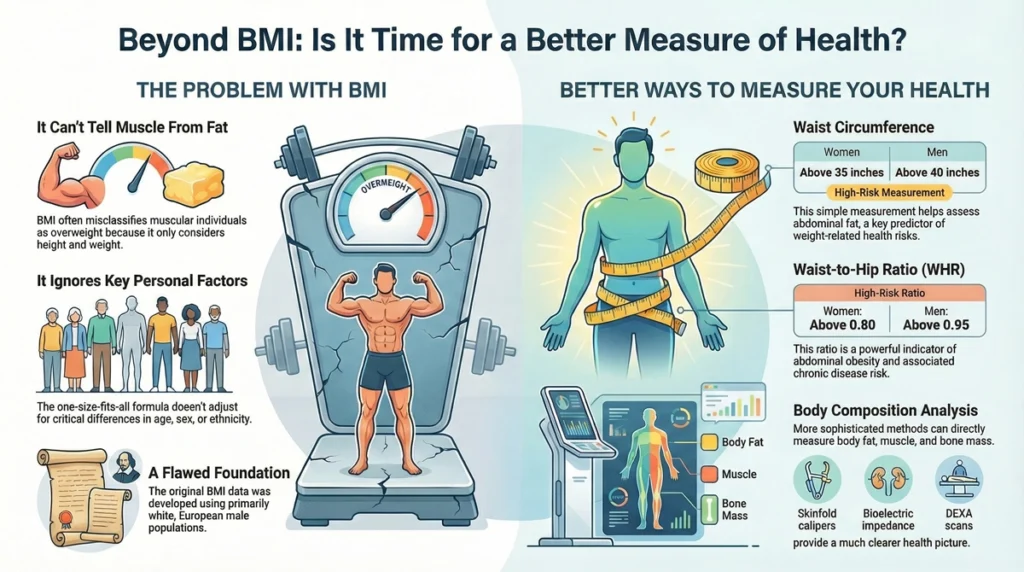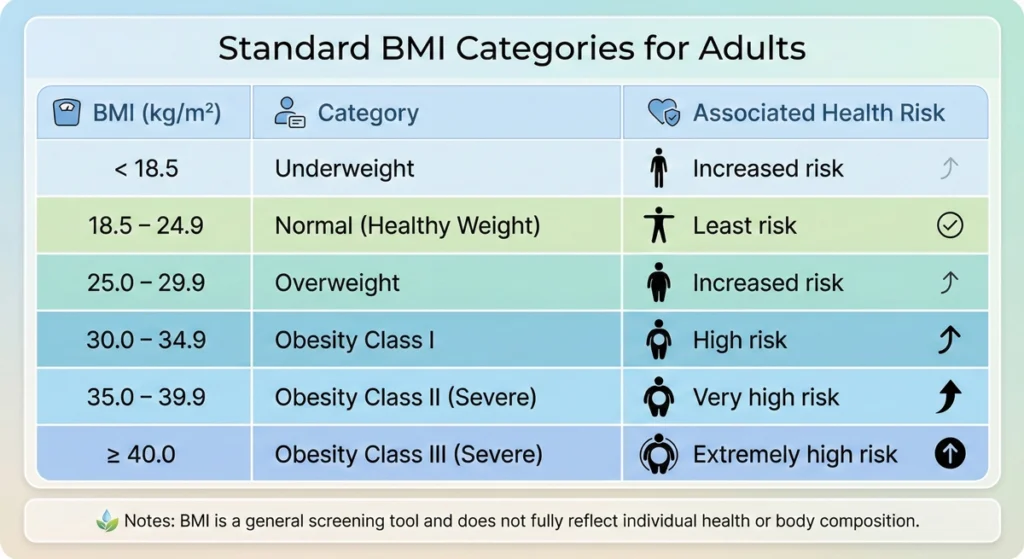If you’ve ever Googled “BMI calculator for women” after a midnight snack guilt trip (we’ve all been there!), you’re definitely not alone. As someone who’s spent years navigating the confusing world of health metrics, I can tell you that BMI is just one piece of a much bigger puzzle – especially for women.
Whether you’re wondering how to calculate BMI for women specifically, or questioning if that BMI calculator you just used is actually telling you anything useful about your health, this post is your friendly guide through it all. Let’s dive into why that simple height-weight ratio might not be the health oracle we once thought it was!
- Understanding the Foundation: What BMI Measures (And How to Calculate It)
- The Critical Flaws: Why BMI is No Longer Sufficient for Diagnosis
- The Modern Assessment: Key Metrics Beyond BMI
- The Clinical Framework: Assessing Obesity as a Chronic Disease
- Actionable Steps for Improving Your Health Profile
- Conclusion: Moving from Index to Individual
Understanding the Foundation: What BMI Measures (And How to Calculate It)

Defining the Body Mass Index (BMI)
So what’s this BMI business anyway? BMI stands for Body Mass Index, and it’s basically a quick-and-dirty calculation invented way back in the 1830s by a mathematician named Adolphe Quetelet. Though it wasn’t actually called “BMI” until a researcher named Ancel Keys popularized it in 1972 (fun fact!).
In simple terms, a BMI calculator for women (or men) uses a super straightforward formula: your weight divided by your height squared. If you’re using metric, that’s weight in kilograms divided by height in meters squared (BMI = kg/m²). If you’re more comfortable with pounds and inches, you’d multiply your weight in pounds by 703, then divide by your height in inches squared.
For example, if you’re a woman who’s 5’4″ (64 inches) and weighs 150 pounds, your calculation would look like:
- 150 × 703 = 105,450
- 64² = 4,096
- 105,450 ÷ 4,096 = 25.7
But here’s the kicker – this exact same formula is used regardless of whether you’re calculating BMI for women, men, athletes, or couch potatoes. And that’s where some of the problems start!
The Standard BMI Categories for Adults
When you use a BMI calculator, you’ll typically get a number that falls into one of these categories:
| BMI Category (kg/m²) | Weight Status | Associated Health Risk |
|---|---|---|
| < 18.5 | Underweight | Increased risk |
| 18.5 – 24.9 | Normal (Healthy Weight) | Least risk |
| 25.0 – 29.9 | Overweight | Increased risk |
| 30.0 – 34.9 | Obesity Class I | High risk |
| ≥ 40.0 | Obesity Class III (Severe) | Extremely high risk |
These categories are the same for both women and men, which – spoiler alert – is part of why BMI isn’t the perfect tool many once thought it was.
Specialized Considerations for Children and Teens
If you’re looking up how to calculate BMI for your kiddo, things get a bit different. For children and teenagers (ages 2-19), BMI calculations use the same formula, but the interpretation changes completely. Instead of fixed categories, their BMI is compared to other kids of the same age and sex using percentile charts.
So your 10-year-old daughter might have a calculated BMI of 19, but what that actually means depends on how she compares to other 10-year-old girls. Is she in the 50th percentile? The 85th? That’s what determines if she’s considered underweight, healthy weight, overweight, or obese – not the adult categories above.

The Critical Flaws: Why BMI is No Longer Sufficient for Diagnosis
BMI Cannot Distinguish Fat from Muscle Mass
Let me tell you about my friend Sarah. She’s been hitting the gym regularly for years, has visible muscle definition, and feels amazing. But according to her BMI calculator? She’s “overweight.”
Here’s the big problem: BMI calculations are completely clueless about what your body is actually made of. That number doesn’t know if you’re carrying extra weight as muscle, fat, bone, or water. A BMI calculator for women who strength train regularly might classify them as “overweight” when they’re actually super fit with low body fat!
Take female athletes, bodybuilders, or even women who just have naturally more muscular builds – they often end up with misleadingly high BMI numbers. Muscle is denser than fat, so strong women can weigh more while actually being incredibly healthy.
Ignoring the Crucial Role of Fat Distribution
Here’s where things get really interesting, especially when we’re talking about BMI calculators for women specifically. Your BMI has absolutely zero clue WHERE you’re carrying your weight – and that matters a ton for your health.
Two women can have identical BMI numbers but completely different health profiles based on where their fat is stored. If you tend to carry weight around your middle (what some affectionately call the “apple” shape), that’s associated with higher health risks than carrying weight around your hips and thighs (the “pear” shape).
Why? Because abdominal fat – especially the deep visceral fat that wraps around your organs – is metabolically active in not-so-great ways. It’s linked to insulin resistance, type 2 diabetes risk, and cardiovascular issues. Meanwhile, hip and thigh fat, more common in women, may actually have some protective effects!
Shockingly, research has found that people with “normal” BMIs but high abdominal fat can actually have higher mortality risks than those in “overweight” BMI categories with less belly fat. When you use a simple BMI calculator for women, you’re missing this crucial distinction entirely.
Historical Bias and Inaccuracy Across Diverse Populations
Okay, here’s where the BMI story gets even messier. That formula I mentioned earlier? It was primarily developed by studying white European men. Yep, you read that right – a measurement we’ve been applying universally was never really validated across different genders and ethnicities.
This creates some serious problems:
- Ethnic Differences: For Asian women, the standard BMI cutoffs actually underestimate health risks. Research shows that Asian women may develop diabetes and heart disease at much lower BMI levels than Caucasian women. Meanwhile, Black women may have less health risk at BMI levels considered “overweight” by standard charts.
- Sex Differences: Women naturally carry more body fat than men – it’s biologically necessary for reproduction! Women typically have 6-11% more body fat than men of the same BMI. Yet we’re using the same cutoff points? Makes no sense!
- Age Differences: As women age, particularly after menopause, body composition changes significantly. Muscle mass decreases while fat often increases, meaning a stable BMI might mask increasing body fat percentage. A 60-year-old woman with the same BMI she had at 30 likely has a very different body composition and potentially different health implications.
Using a standard BMI calculator for women across all these different groups is like trying to use the same shoe size for everyone – it simply doesn’t fit!
The Modern Assessment: Key Metrics Beyond BMI

Measuring Central Adiposity (The Visceral Fat Indicators)
Since we now know that WHERE you carry fat matters tremendously, especially for women, here are some much better measurements you can use alongside (or instead of) that BMI calculator:
Waist Circumference (WC): This is super simple – just measure around your natural waistline (usually right at your belly button). For women, a measurement of 35 inches (88 cm) or greater indicates increased health risk, regardless of your BMI. For Asian women, that threshold is even lower – around 75 cm (29.5 inches).
I love waist circumference because it’s something you can measure at home with a simple tape measure. No fancy equipment needed!
Waist-to-Hip Ratio (WHR): Measure your waist (as above), then measure around the fullest part of your hips. Divide your waist measurement by your hip measurement. For women, a WHR above 0.85 indicates increased health risk. This is especially relevant for women since it factors in our tendency to carry weight in our hips.
Waist-to-Height Ratio (WHtR): Divide your waist measurement by your height. The golden rule here is to keep your waist circumference to less than half your height – regardless of your actual height! Research suggests this might be even better than BMI or waist circumference alone at predicting health risks.
The beauty of these measurements is their simplicity. You don’t need anything more than a tape measure, making them far more accessible than some of the fancier assessment tools we’ll talk about next.
Direct Body Composition Measurement
If you’re really curious about what your body is made of (and not just what the scale says), these are the gold-standard methods that blow any BMI calculator for women out of the water:
Dual-Energy X-ray Absorptiometry (DEXA): This is basically the Rolls-Royce of body composition testing. Originally designed for bone density scans, DEXA can precisely measure your bone mass, muscle mass, and fat percentage – and even tell you where that fat is distributed. It’s the closest thing we have to a truly accurate body composition measurement.
Bioelectrical Impedance Analysis (BIA): Those fancy scales that claim to measure body fat? They’re using BIA technology. A tiny electrical current passes through your body (don’t worry, you can’t feel it!), and since fat, muscle, and water conduct electricity differently, the machine estimates your body composition. Home versions aren’t super accurate, but professional-grade BIA machines can give reasonable estimates.
Skinfold Calipers: This old-school method involves a trained professional pinching your skin at various sites to estimate subcutaneous fat. It’s not as accurate as DEXA, but when done by someone who knows what they’re doing, it’s not bad!
Assessing Overall Functional Health
Let’s be real: the number on a scale or a BMI calculator for women tells you nothing about how fit or functional your body actually is. That’s why these functional assessments are so valuable:
Cardiorespiratory Fitness (CRF): How efficiently can your heart and lungs deliver oxygen during physical activity? This is a powerful predictor of health outcomes. Research has shown that “fat but fit” individuals (higher BMI but good cardiovascular fitness) often have better health outcomes than “normal weight” but unfit people.
Simple tests like how quickly you can walk a mile, how many steps you can climb without getting winded, or how your heart rate recovers after exercise can give you insights into your CRF. For the most accurate assessment, a VO2 max test with a fitness professional is ideal.
The Clinical Framework: Assessing Obesity as a Chronic Disease

Obesity is a Chronic, Progressive, and Relapsing Disease
Let’s shift gears a bit. If you’ve been beating yourself up over your BMI calculator results, please hear this: modern medicine increasingly recognizes obesity as a complex chronic disease – not a moral failing or simply a matter of willpower.
Like other chronic conditions such as diabetes or hypertension, obesity involves complex interactions between genetics, environment, behavior, and physiology. And like other chronic conditions, it often requires ongoing management rather than “one-and-done” solutions.
For women specifically, hormonal fluctuations throughout life – from puberty to monthly cycles to pregnancy to menopause – add additional layers of complexity to weight management that simply aren’t captured by BMI.
Comprehensive Diagnostic Tools
If you’re working with healthcare providers on weight-related concerns, know that modern clinical approaches go far beyond just checking your BMI:
Edmonton Obesity Staging System (EOSS): This fascinating system looks beyond weight to assess how excess adiposity actually impacts your physical, mental, and functional health. It ranges from Stage 0 (no apparent risk factors) to Stage 4 (severe disabilities and end-stage complications). Research shows EOSS is actually a better predictor of mortality than BMI or waist circumference alone.
The 4Ms Framework: This clever approach helps healthcare providers assess:
- Mental health (depression, anxiety, disordered eating)
- Mechanical (sleep apnea, osteoarthritis, reflux)
- Metabolic (diabetes, hypertension, dyslipidemia)
- Monetary health/Milieu (social determinants like food security and environment)
These comprehensive approaches recognize that two women with identical BMI numbers might have completely different health situations and treatment needs.
Actionable Steps for Improving Your Health Profile
Focus on Realistic, Sustainable Goals
If you’ve been fixating on reaching a “normal” BMI, it might be time to shift your focus. Research consistently shows that even modest weight loss – around 5-10% of your starting weight – can significantly improve health markers like blood pressure, blood sugar, and cholesterol, regardless of whether you ever reach that “ideal” BMI range.
For example, if you’re currently 180 pounds, losing just 9-18 pounds could meaningfully improve your health, even if your BMI calculator still says you’re in the “overweight” category.
What matters most isn’t hitting some arbitrary number on a BMI chart but establishing sustainable habits that improve your overall health and quality of life.
Key Pillars of Lifestyle Improvement
Rather than obsessing over BMI, focus on these evidence-based approaches to improve your health:
Balanced Nutrition: Instead of restrictive dieting, aim for a sustainable eating pattern rich in vegetables, fruits, lean proteins, and whole grains. Mediterranean and DASH eating patterns have extensive research supporting their health benefits for women. And remember – restrictive crash diets almost always backfire in the long run!
Joyful Movement: Find physical activities you actually enjoy! Walking, swimming, dancing, strength training, yoga – whatever feels good to your body. For women, strength training is particularly valuable as we age, helping maintain muscle mass and bone density. The goal is consistency over intensity.
Professional Support: If you’re struggling with weight or body composition concerns, consider working with registered dietitians, certified personal trainers, or healthcare providers specialized in women’s health. They can provide personalized guidance far more valuable than what any BMI calculator for women could tell you.
Conclusion: Moving from Index to Individual
While BMI calculators for women remain widely used for their simplicity and accessibility, it’s clear they tell only a tiny fraction of your health story. BMI remains useful for population-level health screening and trend analysis, but it falls short when applied to individuals – especially women, athletes, and diverse ethnic groups.
The future of health assessment lies in a more personalized approach that considers not just your weight and height, but your body composition, fat distribution, fitness level, metabolic health, and individual circumstances. For women specifically, considering how hormonal phases impact weight, energy, and metabolism is crucial for a complete picture.
Remember, health comes in different shapes and sizes. Rather than fixating on a number from a BMI calculator for women, focus on sustainable habits that help you feel energized, strong, and vibrant in the body you have.
So the next time someone asks you about your BMI, you can smile knowingly and say, “Let me tell you about all the other measurements that matter so much more!”